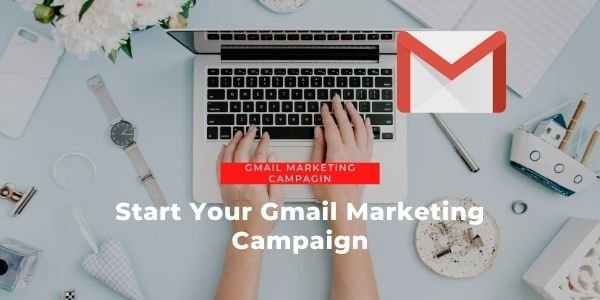The use of social media has become somewhat of a craze in the marketing world and has supplanted other more traditional marketing channels, such as email.
Every year, marketers have access to more and more tools, and while platforms and channels may change, email remains an effective way to keep customers engaged.
You can start your email marketing journey with simple Gmail extensions if you’re worried about learning a whole new tool, like Mailchimp or Mailshake.
You’ll learn how to do it in this guide.
You’ll get some tips on how to make your marketing efforts successful while we walk you through setting up your marketing environment.

What is Gmail Marketing Campaign?
Many reasons contribute to the rapid popularity of Gmail among subscribers, and it all begins with the user experience.
By creating an intuitive user experience, Google raised expectations and established new standards for Internet service providers.
Additionally, Gmail provides significant storage and integration with Google Drive, Calendar, and other tools.
It doesn’t hurt that Android devices come preloaded with the Gmail app since more and more users consume email via mobile devices.
Two-thirds of your subscribers use Gmail, AOL, Hotmail/Outlook, and Yahoo together.
Of the four largest ISPs, Gmail is the only one with growing user numbers – and it is increasingly displacing users from the other providers.
To remain relevant, email marketers should understand Gmail deliverability standards.
Marketers have mixed feelings about Gmail.
Aside from being more subscriber friendly, Gmail has also been more appealing to brands due to its user experience.
Additionally, Gmail introduces a new set of inboxing criteria that marketers will need to account for.
What is the Difference Between Gmail Marketing Campaign and Email Marketing?
The term “single email marketing” refers to one-off emails, like promotions or newsletters, while “campaigns” focus on building a relationship with your subscribers.
You should determine which type of email marketing strategy will work for you depending on how many subscribers you have.
The first few seconds of your email can make or break your impression, so whether you’re sending out a campaign or a single email, you’ll need to get the basics right.
However, what does a campaign actually accomplish? An email campaign is the first step toward building a customer journey.
It’s a series of emails triggered by specific events in the customer’s life. If you run an email campaign, you may send more emails to your customers, but this depends on how they behave.
Gmail Marketing Campaign | A Step by Step Guide
Have you ever considered using Gmail to send emails? It might not be the first thing that comes to your mind when searching for a new email service provider (ESP).
It is usually used by individuals for personal email accounts, not marketing campaigns.
Gmail can be an invaluable tool for small businesses who are looking to expand their email marketing efforts because it’s free.
These tips can help you market your business free of charge with Gmail.
Decide on a Gmail Marketing Tool
You can use Gmail for email marketing with free tools like GMass, a Chrome extension.
You can send personalized mass emails from your Gmail account (up to 500 per day, based on Gmail’s email sending limits). Your first step will be to determine which tool you will use.
You will still use the Gmail interface, but if you want to send mass emails, you need to use an extension.
Gmail marketing tools can make it much easier to manage large email lists without an overwhelming amount of manual effort.
You can choose from several options, including Mail Merge, and Gumbamail.
We recommend using Right Inbox and Yet Another Mail Merge in combination because of their comprehensive features designed for both mass email marketing and more targeted and personalized cold outreach campaigns.
Manage Your List in Google Sheets
Using Google Contacts you can create an email list.
You can add addresses to labels in Google Contacts by selecting the addresses you wish to include.
With GMass, you’ll be able to send a Gmail message to everyone on that list when you’re done.
If you prefer, you can create a Gmail mail merge with Google Sheets, or you can use an email marketing service like Mail Merge that pulls addresses from a Google Sheet and then tracks your email marketing campaigns.
You can only send 500 emails per day if you use Gmail marketing extensions rather than Mailshake and Klaviyo.
It’s likely that you’ll need another solution if you’re planning on mailing more than 500 people.
Then you can manage your email list using Google Sheets in the event that your email list has fewer than 500 emails.
To do so, simply download and install the Yet Another Mail Merge add-on for Google Sheets.
If you’re ready, click “Send XXX emails” from your Google Sheets list.
The list can be managed in Google Sheets, then copied into the BCC field of an email in Gmail.
Ensure You’re Following the Law
There aren’t as many differences between spam and marketing emails as you might imagine.
You can alienate customers and even break the law if you cross that line by mistake.
Make sure you are knowledgeable about the laws in the jurisdiction where you will be sending your first email blast.
There is a potential fine of $42,530 for failing to comply with the law per email.
It would mean a penalty of over four million dollars if you sent 100 spam emails.
There is a CAN-SPAM Act that must be followed in the US.
For instance, the Canadian Anti-Spam Legislation (CASL) and the EU’s General Data Protection Regulation (GDPR) address privacy regulations.
Personalize Your Emails
When you personalize your emails, they will not only get through spam filters, but they will also be more likely to be responded to well.
Personalized emails increased transaction rates by 600% according to a study by Experian.
By using merge fields and list segmentation, you can personalize your emails.
By combining fields, you can create an email that says “Hello David” instead of “Hello customer.”
Segmenting lists is not as straightforward as it used to be. And that leads us to the next point…
Segment Your List
It all comes down to segmenting your list based on demographic factors, user behavior, or other factors.
This allows you to send only the most relevant content to your recipients, increasing the chance that they’ll take action.
Take, for instance, a list of 500 people comprised of 50% men and 50% women.
If this list is too large, consider splitting it into two segments so that you can send different emails to each segment.
Then, maybe you’d like to further separate these lists by age.
The behavior of your lists can also be segmented.
If you want to segment your list, for instance, you could break it down based on what they’ve purchased and what they’ve added to their cart.
Split Test Your Emails
The art and science of email marketing are intertwined.
You need to be creative in writing great copy and designing great-looking emails, but you also need to prove that your efforts are paying off with the numbers.
Split testing is an experiment that you can run on your emails.
One email can be sent to half of your list and another variation to the other half (or any other grouping that makes sense).
Find out which one performs better, and take that example as the basis for future emails.
The low-performer can also be dropped, if it is a recurring email.
Consider first sending to a small part of your list and then sending your winning email to your entire list.
Measure Your Success
You will need to monitor the success of your email marketing efforts as you go along.
Data can be collected manually (for example, through surveys) or with the help of analytics tools.
Click-through rate (CTR) is one of the most important parameters to consider when it comes to email marketing.
You can use this metric to see how many people clicked on a given link in your email, such as a call to action (CTA), versus how many people saw it.
Conclusion
There is nothing better than being the first in something and a lot of people are missing out on this marketing opportunity, to be honest, it’s a bit more complicated than the traditional way of doing email marketing but it’s well worth it.



